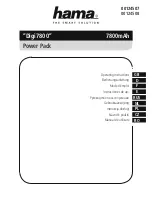
-16-
Model G0495X (Mfd. Since 07/19)
The Model G0495X requires the use of lifting
equipment such as a forklift, engine hoist, or
boom crane. DO NOT try to lift the machine by
hand.
To lift the jointer:
1. Unbolt the jointer from the pallet.
2. Wrap lifting straps around the lifting rods, as
shown in
Figure 7.
Moving & Placing
Jointer
The Model G0495X is a
heavy machine. Serious
personal injury may occur
if safe moving methods
are not used. To be safe,
get assistance and use
power equipment to move
the shipping crate and
remove the machine from
the crate.
3. With lifting straps positioned evenly, lift the
jointer off of the pallet and place it in the
desired location.
Figure 7. Model G0495X supported evenly by
two lifting straps.
Lifting Rods
Anchoring machinery to the floor prevents tipping
or shifting and reduces vibration that may occur
during operation, resulting in a machine that runs
slightly quieter and feels more solid.
If the machine will be installed in a commercial or
workplace setting, or if it is permanently connect-
ed (hardwired) to the power supply, local codes
may require that it be anchored to the floor.
If not required by any local codes, fastening the
machine to the floor is an optional step. If you
choose not to do this with your machine, we rec-
ommend placing it on machine mounts, as these
provide an easy method for leveling and they have
vibration-absorbing pads.
Anchoring to Floor
Lag shield anchors with lag screws (see below)
are a popular way to anchor machinery to a con-
crete floor, because the anchors sit flush with the
floor surface, making it easy to unbolt and move
the machine later, if needed. However, anytime
local codes apply, you MUST follow the anchoring
methodology specified by the code.
Machine Base
Concrete
Lag Screw
Lag Shield Anchor
Flat Washer
Drilled Hole
Figure 8. Popular method for anchoring
machinery to a concrete floor.
Anchoring to Concrete Floors
















































